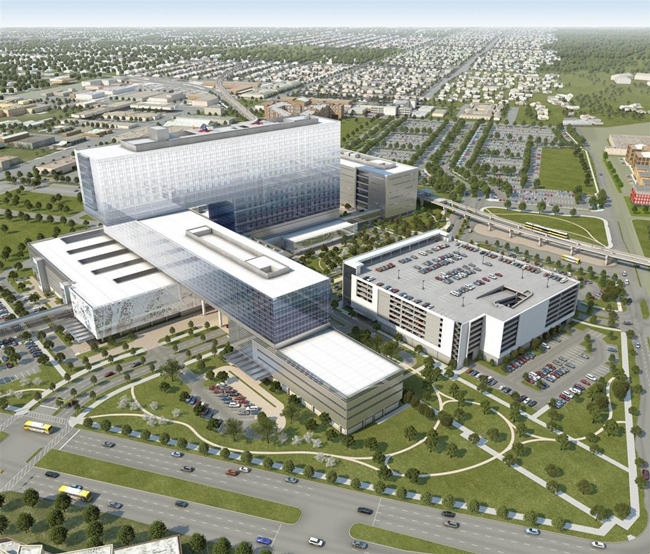
UPDATED 6/28/12: The Supreme Court upheld President Obama’s health-care law in a watershed 5-to-4 decision on Thursday, ruling that an individual insurance mandate is legal because of Congress’s power to collect taxes. Chief Justice John Roberts joined the Court’s liberal wing to support the individual mandate, widely viewed as the most vulnerable part of the law. The ruling was not a complete victory for the President and Congressional Democrats: the Court limited a federal mandate requiring states to greatly expand Medicaid coverage.
On Thursday, the Supreme Court is expected to rule on the Affordable Care Act, either upholding the law or striking it down wholesale or in part. Architects say the looming decision could help jump-start projects and lead to shifts in facility design, although the upcoming presidential election and struggling economy will also play a major role in the future of health care architecture.
While the AIA’s governmental affairs division often weighs in on critical legislation, the institute is staying neutral on the health care reform law. “This is a bill that the AIA took no stance on during the legislative fight, and unless something takes place that specifically affects the architectural community, that’s going to be our stance going forward,” says John Schneidawind, AIA media spokesman.
Many architects say the law’s uncertain future is putting the skids on building projects. “With the major political issues right now, people in health care are generally cautious,” says Hank Adams, director of health care at HDR. “We believe there is a fair amount of capital available, although at this point it’s hard to say when that money will be used.”
Indeed, many hospitals are in holding patterns as they “try to determine the future,” says Dan Noble, executive vice president and director of design at HKS Architects. Noble also is the current president of the AIA’s Academy of Architecture of Health. He says the Supreme Court’s decision will help, but it won’t fully solve the problem. “If the Supreme Court ruling falls in line with the November election—if it rules in favor, keeping the law and Obama wins, or if the court rules in favor of scrapping and Romney wins—there will be a greater chance of getting something done," he says. "This in turn will allow our clients to move forward, benefitting all design professionals big and small.”
Declining Market
According to McGraw-Hill Construction’s Dodge Project Center, health care construction starts have declined in recent years. After peaking at $30 billion in nationwide starts in 2008, the amount dipped to $24.4 billion in 2010 and $23.0 billion last year. Through May of this year, total starts (in square footage terms) were down 24 percent. “Hospitals appear to be taking the brunt of the cuts, as they are down 30 percent,” says Jennifer Coskren, a senior economist with MHC. She says continued uncertainty about the economy and an increase in hospital mergers have led to the decline; the health care reform legislation has led to further uncertainty.
“When the recession hit, every project stopped with the exception of our one major healthcare project: a more than a billion-dollar expansion of Methodist Hospital,” says KPF Principal Jill Lerner. The project, in Houston, sputtered along until 2010. The client said “let’s stop, take stock of things, and reassess when we know where the world is going,” says Lerner. The hospital also opened an outpatient center and several satellite facilities that year and wanted to see if the new buildings met their needs.
One firm that hasn’t seen any project delays is Stantec. “It’s almost the opposite: Our clients think of themselves as thought leaders, and they want to excel and be ahead of the curve,” says Martin Valins, a principal at Stantec’s Philadelphia office.
If the law is upheld, he expects an outcome will be the need for more primary care facilities. “The first port of call will be primary physicians,” he says. In turn, “the primary health-care building stock will become increasingly important, and huge hospitals will become less prominent." Jean Mah, Perkins + Will’s health-care market sector leader, says they’re already seeing an increased demand for smaller facilities over mega-projects. “In looking at physician practice groups, you see leased spaces, ones that may have their own buildings, or even people who work out of their houses,” Mah says.
When it comes to accommodating patients in need of surgery, facility owners are moving more toward outpatient centers. “This is implicit in the Affordable Care Act, but it’s happening anyway,” says Stantec’s Valins, noting that technological advancements have led to minimally invasive surgeries that don’t require overnight hospital stays. “Patients love it. Insurance companies like it. Hospitals like it. Those things are driven by consumer preference and insurance [companies],” he says. When brainstorming for the future, his firm talks about the possibility of bed-less and bathroom-less hospitals, as the conventional hospital may someday be reserved for patients only in need of acute care.
It’s a trend also observed at HOK. “The ambulatory facilities we see today are a different type than we would have done five years ago,” says Chuck Siconolfi, the firm’s director of health-care innovations, planning, and design. “These have procedural activity embedded in them. It’s part of the push toward new medical protocols that enable more efficient and safe care. It’s moving patients through in 23 hours or less. People who might have been inpatients before are now outpatients.”
Cutting Costs
Valins adds that the Affordable Care Act aligns with what most hospitals and architects are already trying to accomplish: reducing costs. In terms of facility design and construction, Stantec is taking a number of money-saving measures. It is abandoning the bid-build process and looking at alternative delivery models, like design-build, to get buildings up faster, says Valin. It also is working to efficiently use materials, even if it means sacrificing design elements. And it’s creating flexible spaces. “We're building hospitals to allow for wiggle room in the future because there may be other reforms and technical advancements down the line,” he says.
The firm is also reassessing evidence-based design. For instance, architects commonly believe that large patient rooms and “same-handed” rooms (where components are in the same location in every room) are the best approach. Valins isn’t convinced by the studies that say that these types of rooms reduce medical errors or decrease patient stays, he says—and they’re more expensive.
HOK says it has done a considerable amount of strategic planning for health care clients in recent years, but that few are moving forward with major projects. “Nobody is able to make big commitments because they can’t do financial modeling to see if these projects will pencil out or not,” says Sheila Cahnman, an HOK vice president based in Chicago. The Supreme Court’s decision will help, but uncertainty will persist until the November presidential election. “We could have a law that is completely copacetic with the Supreme Court’s ruling,” she says, “and then the administration changes.”



Post a comment to this article
Report Abusive Comment